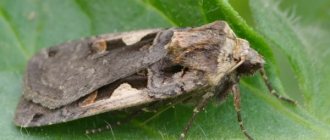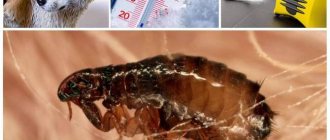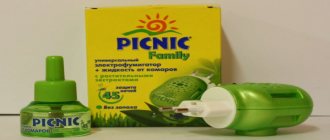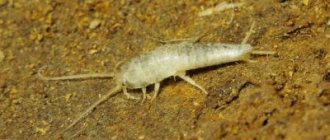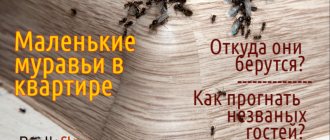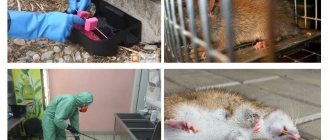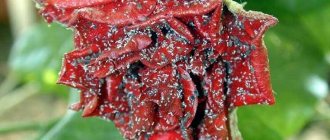Home / Pests and diseases
Back
Published: 10/02/2018
Reading time: 4 min
0
Caterpillars appear when butterflies lay eggs. These small caterpillars are very voracious by nature. In addition, they are unpretentious to environmental conditions. Caterpillars eat the leaves, fruits and flowers of apple trees with equal success, no matter what the weather is, and they do this from early spring to late autumn. If you don't fight them, the worms will completely destroy the apple tree.
In most cases, they are easy to detect; to do this, carefully inspect the tree. Almost all types of caterpillars are large enough to be noticed.
In our area, the most common species found are ermine moths, moths, ringed and gypsy moths, and hawthorn. The most noticeable are the silkworm larvae. The length of their shaggy body reaches seven centimeters in length.
Hawthorn looks much more modest. This black caterpillar is smooth and very small. It's harder to notice.
Such an insidious parasite as a moth larva can generally be detected only by eating leaves, the larvae are so small. If you do not start an urgent fight against the caterpillars on the apple tree, then these “invisible insects” will very quickly multiply and completely deprive the tree of foliage, flowers and ovary.
- 1 Consequences from the pest
- 2 How to get rid of caterpillars on an apple tree
- 3 How to deal with codling moth
- 4 How to treat an apple tree against leaf roller caterpillars
- 5 Traditional methods of struggle
- 6 Chemicals
- 7 Prevention
Consequences from the pest
Initially, the caterpillars hide under the bark of apple trees. At this time, it is difficult to detect them. Meanwhile, they carry out their harmful activities under the bark. Caterpillars are able to gnaw channels in a tree trunk, which contributes to the appearance of fungal diseases, which are much more dangerous for apple trees.
The caterpillars cause the greatest damage when gardens are in flower. They eat buds and ovaries. Luckily, they are easiest to spot on flowers. Apple blossoms are most readily consumed by leaf rollers, codling moths and hawthorns.
It is worth saying that the leaf roller caterpillar also affects gooseberries, pears, currants and garden flowers.
Ways to fight
There are three common methods of pest control:
- Chemical is the simplest and most effective method of exterminating the pest, but there is one drawback - the codling moth is an adaptive insect; control measures using chemicals that were effective last season may be useless this season.
- Use of traps. Simple devices are aimed at destroying adult individuals in order to reduce their number and, accordingly, reduce the number of the new generation.
- Folk methods. These control methods require a lot of labor. When implemented comprehensively, they bring good results.
Each method has many supporters and opponents. Traditional methods are the most accessible and harmless to plants. Chemicals act quickly, but their frequent spraying in large quantities can accumulate in the fruits. Traps require constant updating.
Chemicals (Rovikurt, Decis and others)
Popular pest control drugs:
- Rovikurt is a synthetic agent, the action is enteric-contact. It is represented by an oily liquid of light yellow color. Sold as 5%, 10%, 25% emulsion concentrate. Consumption rate per 10 liters. water: 5% - 50 g, 10% - 25 g, 25% - 10 g. Trees are treated up to two times. The waiting period for action is up to 20 days. The advantages of the drug are an affordable price, a minimum number of treatments, and the absence of a pungent odor. The disadvantages are the destructive effect on bees and other beneficial insects.
- Decis is a paralyzing drug. It begins to act within an hour, the maximum effect is achieved on days 10-14. Available in the form of an emulsion concentrate, in five-liter canisters. The consumption rate is 0.05-0.2 l./ha. The advantages are low washability of the drug, cumulative effect, high environmental friendliness. Disadvantages - cost - from 40 rubles per gram, granular form of release, requiring time to prepare the solution and distribute.
- Binom is an intestinal pesticide in the form of an emulsion. It is highly active immediately after spraying and is not washed off. Sold in five-liter canisters, cost from 750 rubles. It is easily diluted and can guarantee effective action for up to 21 days.
In the fight against codling moths they also use: Karate, Regent, Bankol, Sonnet and other pesticides.
Spraying of drugs is carried out according to the instructions, usually three times:
- The first treatment occurs when butterflies begin to be active - mid-May.
- The second – in 12-15 days.
- The third - in mid-August.
The frequency and quantity of spraying can be adjusted depending on:
- tree infestation;
- climatic conditions of the region;
- manufacturer's recommendations.
Using traps
Pheromone trap. Its action is similar to a cockroach trap. Square or triangular houses are hung on the branches of an apple tree. The inner surface of the traps is impregnated with glue, and a bait impregnated with the CP-MK pheromone is placed in the middle. The trick is designed for males who fly to the smell of the pheromone.
In gardens and plantations, the use of hunting belts is practiced. A belt of thick paper is placed on tree trunks at a distance of 1.5-2 meters from the ground and tied with twine. Paper serves as an excellent place for caterpillars to pupate. Belts should be removed at least once a week to destroy any pests. The trapping belt is used from mid-June to mid-August. In the fall, after harvesting, the belts are removed.
Trap with liquids. The essence of the method is to hang containers filled with sweet compote or syrup on a tree and place them near it. The fruity aroma will attract butterflies, and the stickiness and viscosity of such a liquid will not allow landing individuals to take off. Thus, there is a quantitative decrease in adult individuals, which leads to a decrease in offspring.
How to get rid of caterpillars on an apple tree
In order to successfully fight black and any other caterpillars on an apple tree, you need to take preventive actions and determine what kind of pest is on the tree. If you find gray caterpillars, it means they are hawthorns. If a cobweb has formed on the foliage or branches, this indicates that an apple moth has appeared in the crown of the tree. The presence of leaf rollers on an apple tree causes the leaves to curl.
Preventive actions include spring whitewashing of trunks with lime mortar, timely pruning of branches, proper and regular fertilizing and, of course, watering on dry days. This work should be carried out regularly from early spring to late autumn, then caterpillars will not appear on the leaves of the apple tree.
Varieties and harmfulness of caterpillars
The process of appearance of worm-like larvae is simple - butterflies lay eggs on the back of leaves or on plant stems, from which caterpillars emerge. The larvae remain in this form from several days to several years and constantly harm the plant.
Depending on what the caterpillars feed on, they are divided into four groups:
- Polyphages - absorbing everything in their path and causing the greatest harm to plantings.
- Monophagous - feeding only on a specific plant.
- Oligophages - eating crops and fruits of one family.
- Xylophagous - destroying bark and wood.
Each group has its most dangerous representatives. Not all caterpillars pose a threat to agricultural crops, however, among them there are such serious parasites that can easily destroy the yield of some vegetables and fruits.
The most harmful caterpillars on a summer cottage include the larvae of cabbage moths, cutworms, gypsy moths, lacewings, and leaf rollers. They differ in the type of food, size and color.
Black
Black caterpillars found in the garden can be harmless peacock moth larvae and dangerous larvae of the armyworm and gypsy moth. The offspring of the peacock's eye are frightening in appearance, but practically do not harm most country plants. Black larvae with long spines live mainly on weeds - nettles and thistles. They are less common on raspberry bushes.
In spring and early summer, large colonies of caterpillars can be seen hanging from plants in clusters. A large number of peacock eye larvae can cause damage to raspberry plantings, however, timely processing of berry bushes will help preserve the harvest.
More significant damage to plants is caused by the larvae of the warlike moth, a gray-brown moth-like moth. Black 4-centimeter polyphages can significantly reduce the yield of fruit trees and shrubs. This caterpillar is often found on sunflowers.
The voracious offspring of the gypsy moth can be recognized by their dark color with orange dots. These larvae grow up to 7 cm and eat flowers and leaves of apple trees. If caterpillars are found, they must be exterminated without delay, otherwise you may lose your apples.
Gray
Gray caterpillars with a greasy sheen, growing up to 5 cm, are the larvae of the moth. They appear in two stages, develop quickly over 5-10 days and are so insatiable that in just a few days they can completely deprive the plant of green leaves. The first stage caterpillars hatch from June to July and destroy seedlings of sugar beets, corn and sunflowers. The larvae of the second stage appear from August to September and parasitize mainly on vegetables - potatoes, beets, etc.
Interesting! In one night, about 5 cutworm caterpillars can destroy a dozen plants.
Greens
Mostly green caterpillars are common in the country. From them appear cabbage whites, raspberry moths, cabbage cutworms, leaf rollers, and onion moths. The ones to be most wary of are female white moths, which lay several hundred eggs per season on cruciferous vegetables. Butterfly caterpillars are very aggressive and voracious; they quickly eat up plants, not allowing a head of cabbage to form, and then move to neighboring plantings.
Cabbage is attacked not only by white moth larvae, but also by cabbage cutworm. Cutworm caterpillars are difficult to detect - they feed mainly at night and hide during the day. Their presence can be judged by the holes on the leaves of vegetables. Another species of butterfly that is dangerous to plants is the leaf roller. Two-centimeter polyphagous larvae damage all fruit trees and berry bushes. They can be found on honeysuckle, currants, raspberries, apple trees and pears. If you find a small green worm on a tree, you must immediately treat the plant with a special product.
Onion moth caterpillars develop and parasitize garlic and onions. These tiny insects devour the leaves of bulbous plants, gnaw through the stalks, shoot tissue and penetrate the bulb, which leads to the inevitable death of the plant. Caterpillars that parasitize raspberries and currants, wild shrubs and trees turn into bright green raspberries. Fortunately for gardeners, these beautiful butterflies are quite rare in nature, so they are practically never found in summer cottages.
White
Pale, tiny whiteflies are a source of headaches for gardeners. A small insect systematically destroys a plant at all stages of its development. Larvae and adults of the butterfly feed on vegetable seedlings and leaves of fruit bushes, in particular red and black currants.
Whitish worms can be seen on tomatoes, cucumbers, and peppers. During the growing season of plants, several generations of whiteflies appear, causing significant damage to the crop.
Yellow
Yellow larvae hatch from the eggs of the corrosive woodworm. Caterpillars feed mainly on wood, infect the trunk of plants with bacteria, and gnaw tunnels in the trunk and stem. As a result of the parasitic activity of caterpillars, plant branches become fragile and brittle.
Apple glass caterpillar
In addition to woodworms, xylophages include the offspring of the glass butterfly, which causes serious damage to garden trees. The larvae hatching from eggs laid in the bark gnaw passages in the trunk of the plant, which also disrupts the circulation of sap. Despite their name, glassworm caterpillars also parasitize plums and pears. If you spray the plants in a timely manner immediately after flowering, you can get rid of glass larvae for a long time.
Codling moth caterpillar
There is an opinion among summer residents that for every fruit there is its own codling moth. Apple, plum, pear and barberry trees fall under the attack of butterflies. The larvae of apple and plum moths are the most insidious, as they are oligophages. The danger of codling moth caterpillars is that they damage fruits and young leaves of shoots, causing the entire shoot to die. The worms penetrate the fruits, chew them out from the inside, and then move on to another untouched fruit.
Multi-colored bright caterpillars
Colored hawthorn and lacewing caterpillars pose a serious threat to agricultural crops. The shaggy gray-orange hawthorn caterpillar prefers to parasitize pink-flowered plants - apple trees, rose hips, almonds, and cherries. In a short time, it gnaws out buds, buds and leaves.
Large four-centimeter lacewing caterpillars, attracting attention with their red color with bright orange speckles, are dangerous not only for plants, but also for living beings. The hairs covering the caterpillar's body can cause an allergy attack or cause a burn to the skin.
How to fight the codling moth
The codling moth is very common in our gardens. Its pupae spend the winter in the soil near the trunks of apple trees. With the onset of spring, butterflies emerge from the pupae and lay eggs on the leaves of the apple tree. It is difficult to see them; they are extremely small. In early summer, tiny worms hatch from these eggs. These are the caterpillars of the moth. They feed on the core of the fruit, rendering it unusable. Under their influence, unripe apples fall. How to treat apple trees in June?
To successfully combat the pest, first of all, collect all fallen apples and destroy them. Adhesive catching belts, which are attached to apple tree trunks below the very first branch, have proven to be very effective.
After the apple tree has finished flowering, treat it with insecticidal preparations. This is a solution of chlorophos (0.2%) or karbofos (0.3%). Experienced gardeners first spray one tree and watch it for a day. If nothing bad happened to the apple tree, then the remaining trees are treated.
What types of caterpillars live on apple trees?
Today there are many known species of caterpillars that infect apple trees. They negatively affect the development of the tree and reduce productivity.
Apple glass caterpillar
It is a white and yellow individual (2.5 centimeters). This parasite exclusively affects apple trees. When attacking a tree, it makes moves in the trunk and shoots of the crop. As a result, the affected branches die.
The attack of glassweed is associated with cracks and frost holes in the bark. To avoid this, it is recommended to whiten the trunk in the fall and promptly treat the wounds. With the arrival of spring, it is permissible to use special products - for example, Fitoverm.
Codling moth caterpillars
This pest poses a danger to trees. It overwinters in the bark or soil, forming a dense cocoon. After the apple tree has finished flowering, the codling moth lays eggs on the foliage and in the structure of the ovaries. As a result, the caterpillars get into the apples and make holes in them.
Catching belts help to cope with codling moths. They are attached to tree trunks. Spraying with insecticides helps eliminate pests. The procedure is carried out several times during the season.
Yellow
Hawthorn has this color. These caterpillars have black longitudinal stripes and reach 4.5 centimeters in length. You can see uneaten veins on the affected leaves.
Small apple moth caterpillars have this shade. They have black spots along the body. These parasites pose a danger exclusively to apple trees.
White
Trees often suffer from attacks by white caterpillars. Most often you can find glass moth and codling moth on apple trees. Recently, corrosive tree moths and fruit moths have often been encountered. The plant may also suffer from the eastern codling moth.
To deal with parasites, it is recommended to find their nest. It is a hole in the bark. It is recommended to open the nest and get rid of the remains of parasites. Then treat this area with insecticide and copper sulfate. Finally, cover the damaged area with garden varnish.
Greens
Green caterpillars are characteristic of the winter moth. Their size reaches 3 centimeters. When moving, pests arch their bodies in an arc. They affect different parts of trees. Parasites lay eggs in the bark, caterpillars accumulate in the crown, and pupae are on the ground.
These small insects attack buds, flowers, and leaves. During their life, pests form webs. To cope with the winter moth, mechanical methods are used. To do this, install adhesive belts. Thanks to this, it is possible to catch and destroy parasites.
You can also use natural products to treat wood. A decoction of yarrow is suitable for this purpose. Tobacco infusion is considered no less effective. The tree trunk circle should be dug up.
In spring, you can see a leaf roller on a tree. It is a green caterpillar, the length of which does not exceed 2 centimeters. Parasites attack leaves, buds and buds. In mid-July, leaves rolled into a tube, on which cobwebs are visible, help identify pests.
Gray
An apple tree can be damaged by the ringed silkworm, a gray caterpillar with blue stripes.
For a small number of pests, treatment with a herbal decoction is sufficient.
In advanced cases, it will not be possible to do without chemicals. In such a situation, it will be enough to treat the plantings with Karbofos once. This is done before flowering begins. If the temperature is more than +15 degrees, it is permissible to use Lepidocide or Bitoxibacillin.
Black
Apple trees can be affected by several varieties of black caterpillars. These include the gypsy moth. It is a large, furry caterpillar, reaching 7 centimeters. The parasite leads to damage to leaves, flowers and ovaries.
The formation of silkworm cocoons occurs in June. Already in July, butterflies emerge from them, laying more than 1000 eggs in the foliage. If masonry is discovered, it should be removed. Before buds appear, it is recommended to spray the tree with Nitrafen. Before flowering, insecticides with malathion are used.
See also
Description and characteristics of the Mutsu apple variety, growing technology
Read
How to treat an apple tree against leaf roller caterpillars
Green caterpillars emerge from the eggs of leaf roller butterflies. They love apple buds when they are still young, then they switch to flowers, and then to leaves. The waste products of leaf roller caterpillars look like cobwebs. Under its influence, the leaves curl into tubes, inside which the caterpillar lives.
How to deal with apple tree pests? Mechanically. Tear off all curled leaves and burn. If in the spring there are too many of these pests on the tree, then before flowering, spray the apple tree with a 3% solution of nitrafen. Repeated treatment can be done no earlier than two weeks later.
Types of pests
Aphids on an apple tree: how to fight
If almost black caterpillars with bluish stripes on their backs were found in the crown of an apple tree, these are ringed silkworm larvae. They can sit motionless throughout the day, and at nightfall eat flowers and apple tree leaves. To repel larvae, it is recommended to use a tincture of milkweed or wormwood. Apple trees need to be irrigated until the buds bloom.
If you noticed cobwebs on trees in the spring with green caterpillars inside, these are winter moths. Each caterpillar has one dark stripe on the side and three light, barely noticeable ones. These larvae live in and feed on the buds, and in June the caterpillars begin eating flowers and foliage. In order to catch the parasites, you need to wait until autumn and build fishing belts on the trunks of the apple tree.
If the web contains gray caterpillars, whose bodies are decorated with small hairs in the form of tufts, these are gypsy moths. They are able to move from one tree to another with the help of the wind.
Gypsy moths
Attention! With the onset of spring, the trunk of the apple tree should be carefully examined, and if clutches are found, they should be scraped off with a knife and treated with kerosene.
The worms on the apple tree are the larvae of the codling moth. The butterfly is capable of laying eggs while being on the reverse side of the leaf. After two weeks, the caterpillars hatch, which have a pinkish tint and a brown head, their length is 20 mm. Throughout the spring, young codling moth larvae feed exclusively on buds and buds. After they pupate, they acquire a yellow-brown hue, and their length does not exceed 13 mm.
In most cases, leaf roller butterflies cause curling of apple tree leaves. While other types of butterflies fold their wings vertically, the leaf roller folds its wings horizontally. The butterfly has a grayish tint, is active at night, and the size of its wings is 20 mm.
Leaf roller butterflies
If a young apple tree is affected by cobwebs, this indicates that the apple worm, which is popularly called the psyllid, has settled on the tree. The size of small pests does not exceed 3 mm, and their eggs are yellowish-orange in color. The psyllid lays eggs for the winter, choosing secluded places for this purpose. This often occurs in ringlets or folds of the bark.
The larvae feed on sap, and their excrement - sticky balls - causes the apple tree to become infected with sooty fungus. This disease causes blackening of leaves and flowers, which dry out over time. When the apple tree stops flowering, the larvae become adult psyllids, which are again ready to lay eggs on the tree's leaves.
Folk methods of struggle
Gardening goes back thousands of years and, of course, during this time people have come up with many folk remedies for killing caterpillars on apple trees.
Washing off the caterpillars with a tight stream of water is a fairly effective method. Of course, all caterpillars need to be collected from the ground and destroyed.
Black caterpillars can be successfully combated by shaking the branches of apple trees. These insects practically do not stick to leaves or branches and immediately fall to the ground even with gentle shaking. Before doing this, you need to spread a film on the ground so that the parasites can be easily collected and burned.
If you plant tomatoes between the rows of apple trees, the smell of their tops will repel caterpillars.
Glue belts on the trunks of apple trees will prevent the larvae from reaching the crown.
In early June, apple trees can be sprayed with a rich decoction of pine needles, celandine, tansy or burdock. Caterpillars cannot stand their smell. Two weeks after the end of flowering, it would not hurt to repeat this treatment again.
The caterpillars also do not tolerate the smell of tomato tops decoction.
A decoction of wormwood or yarrow also helps get rid of caterpillars.
No less effective methods of combating caterpillars are solutions of baking soda, vinegar or laundry soap. You can use ash instead of baking soda.
Traditional recipes have one drawback. They need to be alternated, since caterpillars are able to adapt to a specific means. You can treat apple trees with these products at intervals of one week.
Reasons for the appearance of cobwebs on apple trees
First determine who has chosen the tree. On the apple tree you can find:
- spider mite - a small insect up to 0.5 mm long, develops quickly, damages branches, fruits, foliage;
- hawthorn - a black and white butterfly, the wingspan of which reaches 65 mm, feeds on foliage, buds, buds, and is capable of making branches completely bare;
- copperhead - a small insect up to 3 mm long, preferring young trees, lays eggs in secluded places: folds of bark, branches of branches;
- apple moth - a small white butterfly that lays eggs near the buds, in places where branches branch;
- spider aphids - small green or gray parasites, one insect lays up to 100 larvae at a time;
- gypsy moth - a gray caterpillar with visible hairs on its body;
- winter moth - a green caterpillar with light stripes on the sides, eating buds and foliage;
- The ringed silkworm is a dark-colored caterpillar with blue stripes on its back, feeding on flowers and foliage at night.
Chemicals
The use of chemicals to combat caterpillars is a last resort when it is impossible to get rid of them by other means. Here we are talking about the use of poisons. Use chemicals strictly according to the instructions, which are always printed on the packaging. You need to work with them wearing protective clothing, rubber gloves and goggles. Be sure to use a respirator.
- Intavir is available in tablet or powder form. No more than three treatments per season are allowed.
- Tanrek is a systemic drug. The product has a detrimental effect on caterpillars within three weeks. It can be used only before the apple trees begin to bloom and after the harvest is completed.
- Karbofos and Fufanon. Both drugs have a contact method of influencing caterpillars. Under their influence, insects' digestive systems are paralyzed and they die of hunger. The insecticides contain malathion, which lasts ten days in the absence of rain. These products can only be used during the growing season of apple trees, no later than 3 weeks before the start of apple picking. No more than two sprayings are allowed in one season.
- Fitoverm does not contain chemical toxic substances; it is a biologically active means of combating insects. One ampoule is designed for 2.5 liters of water. You cannot spray apple trees with this product during flowering.
Features of treating plants against caterpillars
When exterminating pests, it is important to follow certain rules:
- Adhere to processing deadlines.
- Do not get carried away with chemicals - you should use toxic compounds as a last resort, without exceeding the dosage.
- It is necessary to poison insects in dry, windless weather in the morning or evening hours.
- Wear protective equipment when using chemicals.
- Follow the rules of hygiene - after treatment you need to wash and change clothes.
- Destroy any remaining funds rather than storing them until next use.
- Do not harvest within 30 days after spraying.
Prevention
- Inspect apple trees regularly to detect harmful insects and their larvae.
- In the spring, destroy all egg-laying and spider nests found on the tree, and also whiten the trunks with lime mortar
- Throughout the season, pluck and burn all the leaves rolled into a tube.
- Periodically spray the soil under apple trees with endobacterin.
- Don’t be lazy to spray apple trees with folk remedies against caterpillars.
- Place several feeders in the garden for birds that eat caterpillars.
If you follow the entire complex of the above measures, then caterpillars will not appear on your apple trees, which means that you will definitely reap a good harvest of tasty apples.
Preventing the appearance of caterpillars on fruit trees
To reduce the number of larvae and adult insects, it is necessary to regularly inspect apple trees and other fruit trees and carry out the following activities:
- in the spring, inspect the bark on the trunks, burn nests with cobwebs, damaged leaves and detected oviposition;
- carry out bleaching and treatment of the trunk and apple tree of the soil around it with biological products (Endobacterin, etc.);
- regularly use herbal infusions for spraying and protection against pests;
- hang bird feeders in the garden that attract birds, which can destroy a large number of caterpillars and other pests.
Such an integrated approach to the fight against caterpillars on apple trees will help destroy the maximum number of pests, protect fruit trees and grow a rich harvest of apples.
How to spray bushes and trees against diseases and pests in spring
The variety of drugs and popular advice is so large that inexperienced gardeners begin to doubt their effectiveness, because they want to immediately treat the garden with a good product, without serious consequences for the shrubs.
Biological agents
Biological products are one of the most popular means of protecting the garden from insects, allowing them to effectively act against pests and their larvae, without leaving other damaging substances on the plant, after which the fruits from these bushes cannot be consumed for a long time.
These drugs have different bases:
- based on fungi (antagonists), such drugs effectively act not only on adult insects, but on larvae and caterpillars (Averin-N, Basamil, Pecilomycin, Mikoafidin, Verticillin);
- based on bacteria, their cost is quite high and quite difficult to find on sale, they are produced in the form of powders (Bikol, Bitoxibacillin);
- based on microscopic nematodes that penetrate inside the insect, caterpillars and kill them within a few days, but the disadvantage of such drugs is that they do not affect parasite eggs, which means that the treatment will need to be carried out again after 7-10 days (Nemabact, Antonem- F).
Chemicals
Along with other means, chemical insecticides have become more widely used, since the effect after their treatment is quick and quite long. No matter how much a gardener would like to grow everything without chemicals, sometimes this is impossible, especially if there are neglected areas in the neighborhood from which thousands of pests migrate annually.
Chemicals have several hazard classes, but usually the least dangerous class 4 insecticides (Fitoverm, Agravertin) are used in the garden.
- Class 1 is the most toxic, very dangerous for humans, so you should act strictly according to the instructions and do not consume fruits for more than 20 days from treated bushes (Phostoxin, Magtoxin).
- 2nd class - highly dangerous, such as: Actellik, BAF, OMITE-30, Vertimek, Calypso.
- 3rd class - moderately dangerous: Karate, Dichlorvos, Decis, Karbofos, Inta-Vir, Fufanon.
They are also divided into 4 groups:
- contact – influence the insect through external contact (Spark);
- intestinal – penetrate with plant juice or sprayed leaves, bark into the pest’s body, is absorbed into their intestines, causing the insect’s death;
- fumigants are mainly products in the form of aerosols that are sprayed onto surfaces and enter the insect’s body through the respiratory system, which causes irreversible processes and the pest dies (Phostoxin);
- systemic - after spraying, the plants enter the sap of the plant, which already contains poison, and then die. As a rule, these drugs have a higher hazard class and are more toxic (Aktara, Bazudin).
Acaricides are classified into a separate group; they act selectively on groups of insects, mainly varieties of mites (Neoron, Aktellik, Omite).
Traditional medicines
It is difficult to imagine any gardener in the garden without folk remedies; everyone has used it at least once in their garden.
In the spring, at the stage of active bud growth, shrubs begin to be affected by aphids, whiteflies, spider mites, flea beetles and others, so gardeners try to use folk natural remedies that will remove pests and not harm other pollinating insects.
- against aphids and ticks, leaf rollers make a mixture of tar soap and lemon juice;
- from copperheads, aphids and their larvae, mites and various butterflies and flies - use an infusion of garlic, grind 0.5 kg of garlic and pour 1 liter of hot water, leave for 2 days and dilute in 15 liters of water. This is sprayed on leaves and shoots, as well as around bushes.
- Ground black pepper, scattered on sticky leaves and aphids, allows you to get rid of them and ants for a long time.
- tobacco infusion helps remove ants, aphids in various stages of development, leaf rollers, moths, onion flies, sawflies and caterpillars from plants. 500 g of tobacco is poured into 5 liters of warm water, left for 24 hours, then filtered and another 5 liters of water and a dissolved 200 g piece of laundry soap 72% are added.
- mustard powder scattered between rows will save plants from slugs, mole crickets, and snails.
Preparations for spraying fruit trees
Each type of preparation for treating fruit trees is described below.
For every ailment there is a suitable drug
Biological agents
The advantage of biological preparations is that they have a gentler effect on plants: they do not cause burns and do not accumulate in the soil and fruits. This means that they can be used in processing more often than chemicals.
But with all the advantages, there are also disadvantages: such substances act more slowly than any others, so the result will not be noticeable immediately.
Important! Biological agents act due to the living bacteria in the composition, so such drugs can only be used at a stable air temperature of 10 ° C and above. The most effective of all drugs of this type are the following:
The most effective of all drugs of this type are the following:
- phytosporin-M acts on fungal and bacterial lesions, kills their viruses and spores;
- pentaphage fights scab, bacterial cancer and leaf spot;
- trichodermin - a remedy for fungus and rot, does not give side effects, can be used after bud formation;
- planriz saves from rot, rust and winged insects;
- “Phytodoctor” fights late blight, bacterial cancer and fusarium;
- Nemabact is effective in pest control, affecting both larvae and adults;
- mikosan increases the immunity of trees (replacing fertilizing), protects against viral, fungal and bacterial diseases;
- guapsin fights earwigs, aphids and flies, feeds garden crops with nitrogen, which is contained in the composition;
- “Healthy Garden” saves you from late blight and insects that attack the leaves of fruit trees;
- Riverm is the fastest-acting biological preparation, it gives effect within 30 minutes, and fights fungal diseases well.
Biological agents act due to microorganisms in the composition
Folk remedies
At any stage of growth, the tree needs active protection. Aphids that attack a plant during the period of leaf blades blooming or during the formation of buds weaken the crop. Against this background, productivity decreases and crop growth slows down.
Among the most effective folk remedies to cope with aphids are:
- spraying plants with herbal infusions;
- treatment with a solution containing tar;
- whitewashing of the stem part;
- spraying leaf plates with soap solution and urea solution.
Tobacco dust can effectively control aphids
Also quite effective in the fight against aphids:
- garlic tincture. 55 g of chopped garlic will need to be mixed with 5.5 liters of settled rainwater. The ether will help repel aphids and protect the surface of the leaf blades from fungal infection;
- ammonia tincture. Add 40 ml of ammonia to 10 liters of water. After stirring the composition, you should leave it for at least a couple of hours and spray;
- tobacco tincture, for the preparation of which you will need to mix 120 g of dry tobacco with 600 ml of water. It is necessary to spray the plants in early spring before bud set.
Herbal remedies
Herbal infusions are often used to treat trees in the spring against pests and diseases. It is advisable to use them in combination with another method, which will increase the effectiveness of the procedure. The components included in the folk remedy effectively repel aphids. Most often, gardeners use celandine, potato tops and tomato tops. Greens are mixed in equal quantities in a bucket and poured with boiling water. It is recommended to infuse the composition for 2-3 days, after which you can spray.
Main types of caterpillars - pests
There are countless insects whose caterpillars cause damage to garden crops and are a nuisance to gardeners across the country. Green caterpillars on apple trees and flowers, yellow-brown caterpillars on cabbage, black caterpillars on nettles are not the best neighborhood for a gardener. We will consider the most common types in detail below.
hawthorn
Hawthorn caterpillar
Although the hawthorn butterfly itself does not pose any harm to fruit and berry trees and shrubs, being an excellent pollinator, its offspring can cause serious damage to plantings, significantly reducing their yield.
They are found throughout our country.
So, let's figure out what a hawthorn larva looks like. Adults are variegated in color - gray, with two bright yellow-orange stripes along the entire body, on the back and one black between them. The body reaches a length of 4-4.5 cm. Protection in the form of numerous bristle hairs repels most birds.
The caterpillar has such a great appetite that in addition to garden crops such as apple trees, pears, plums, cherries, apricots, it enjoys eating other fruit and berry plants: rose hips, bird cherry, blackthorn, rowan, and, of course, hawthorn. As you might guess, the pest was given its name in honor of the latter. The voracious larvae are able to eat the entire foliage, leaving only hard veins.
You can recognize that a tree is affected by hawthorn by its branches braided with silky threads. Inside this kind of shelter, the larvae feel safe.
Goldentail
Goldentail
This butterfly, and primarily its larval stage, is the most common garden pest. A small creature, 3-4 centimeters long, painted black with a white longitudinal stripe. On the back there are segmental growths of thick red hairs. In the front part of the body there are glands that secrete a poisonous secretion that, upon contact, causes a burning sensation and allergic reactions on the skin.
You should know that when shedding, these prickly red hairs are easily carried by the wind and, if they get into the respiratory tract, cause a cough.
Lacewings are extremely destructive due to their insatiable appetite and long active period, lasting from April to September. In addition to leaves, the caterpillars eat up young buds, and a colony of parasites can easily destroy all the greenery within a meter radius. As a result, the trees are completely exposed, which leads to a complete loss of the crop, up to and including the death of the crop.
Gypsy moth
Silkworm
The silkworm belongs to the moth family and is characterized by sharp differences between females and males. Distributed throughout Russia and the countries of Middle Asia. In a number of countries it is considered a quarantine insect due to its high fertility and passion for wild and cultivated plantings. The gypsy moth larva can reach a length of up to 7-7.5 centimeters. The body, like the head, is dark gray in color, covered with long hairs growing from paired warts. There are subtle white stripes on the back.
The caterpillar of this pest feeds on the foliage of a huge number of trees and shrubs, such as apple, plum, birch, poplar and others, about three hundred species of plants. They are also capable of destroying crops of cereals and root crops.
Interestingly, the parasite does not affect pear trees, honeysuckle, or elderberry.
A large colony of insects can completely devour all the fruit and berry trees on your site.
leaf roller
leaf roller
Among garden pests, the leaf roller occupies not the last place. However, this insect is highly adaptable to any conditions, which makes it dangerous for wild plants. About more than 20 species live on the territory of our country. The most common and destructive ones are listed below:
- Buraya;
- Fruit;
- Rosanna;
- Currant;
- Kidney spinner.
The caterpillars of this insect, unlike the previous species considered, have a smooth body of pale green and yellow-brown color with a dark head.
If you try to throw a caterpillar off a leaf, it will hang on a thin web.
The leaf roller got its name because of the way it grows on trees and bushes. The leaf beetle wraps itself in a leaf, entwining the inside of its peculiar home with a silver-white web.
If you find curled leaves on fruit and berry plants, quickly take measures to destroy the colony. How to get rid of green caterpillars is a question that worries many.
Cabbage butterfly
Cabbage butterfly
This butterfly and its offspring can be found in almost every garden plot, especially in cabbage heads. The cabbage caterpillar or cabbage white caterpillar has a yellowish-green body with mottled black spots, covered with sparse hairs. Newly hatched individuals prefer to stay in small groups, but as they mature, they spread throughout the entire area.
The basis of the insect's diet is represented by garden crops of the cruciferous family, such as cabbage, broccoli, radishes, turnips, radishes, beets and others. Adult cabbage larvae have a voracious appetite, and if a colony of leaf beetles on cabbage is not detected in a timely manner, the risk of crop loss increases.
This is what a colony of voracious individuals turns cabbage into.
It is important to know that excrement left by parasites, as a result of their vital activity, can provoke diseases of garden crops.
In addition to the pests described above, there are many types of creepy crawlies that can take up residence in your garden, such as: Redtail; Hawkmoth; Swallowtail; Moth; Cabbage scoop.
You must not allow creeping insects to take over your garden plots, and it is even more unpleasant to find caterpillars in your apartment. To prevent this, there are a number of effective ways to combat it, which we will discuss below.
Number and timing of garden treatments
In gardens with modern protective work, it is practical to observe the following deadlines, using both chemical and biological preparations:
- first treatment on June 1-12 with chemical vapors to destroy the first generation of caterpillars,
- to destroy the second generation, count 25-30 days from the first treatment and approximately July 10 (+...- 3 days), treat the trees a second time with a different composition of chemicals,
- the largest accumulation of caterpillars (several generations) is observed from the second half of July; therefore, from July 18-20 to August 1, 2 more treatments are necessarily carried out, but with biological products; in between, you can add treatments with herbal decoctions (folk method),
To reduce the load of number of treatments on the tree, it is better to combine treatments against codling moths (gnawing) with other types of pests (sucking) in tank mixtures, having first checked the compatibility of different preparations.
Control of pests and their caterpillars
Prevention, as we know, is the key to health. This formulation is also relevant in relation to the garden. No matter how safe modern insecticides are, you want to reduce their quantity to a minimum in order to get a truly organic harvest. And to do this, you need to regularly “walk around” your property, checking the plants for the presence of clutches of caterpillars. Leaves entangled in cobwebs should be immediately removed and destroyed.
In autumn, it is advisable to remove fallen leaves, this helps reduce the number of pests in the area
One of the methods of prevention is whitewashing trees, which protects plants not only from insects, but also from sunburn. Digging up a garden plot is also quite effective. Small grooves around the perimeter prevent many caterpillars from reaching the garden. The grooves need to be cleaned periodically.
Treatment of trees and shrubs - what to use?
With the onset of warmth and snow melting, you can begin the spring inspection of fruit trees and shrubs with a view to further processing them. First of all, it is necessary to trim off excess diseased branches and twigs, clean the trunk of dead bark and lichen present on it. The cleaned areas should be treated with garden varnish or other special means.
Next you should follow the following sequence:
Whitewashing of plants. Typically, a slaked lime solution is used for whitewashing, which is applied in two layers to enhance the effect. Currently, products for whitewashing trees and shrubs containing copper sulfate and PVA glue have appeared on the market. This composition is more stable than lime mortar, and protects against pests and disinfects the bark.
Digging up soil. 3-4 days before spraying the trees, you need to dig up the soil around them in order to bring the pests to the surface, where they will be destroyed.
Spraying. You can start spraying all trees and shrubs from the end of March. It is better to carry out the treatment in the evening.
Various preparations are used to treat trees and shrubs. The following types of chemicals are most often used.
- Even before the buds swell (preferably at the end of March), you should spray all the trees and bushes on the site with a solution of copper sulfate (take 100 grams per bucket of water). This will help avoid fungal diseases, the formation of mosses and lichens, black cancer, and scab. Bordeaux mixture also helps a lot. These are the most popular and proven means.
- To protect grapes from spotty necrosis, anthracnose and bacterial cancer, they need to be treated with an aqueous solution of iron sulfate (200 grams of product per bucket of water), spraying the vine and the soil under the plant. The procedure must be carried out before the kidneys swell, until mid-April.
- Pears and apple trees must be treated before flowering with Iskra-M, Fufanon, and Karbofos. They are able to prevent the appearance of ticks, weevils, flower beetles, and copperheads. If the pests have already settled on the plants, then the treatment must be carried out twice. The second time - after flowering.
- To destroy insects that have overwintered in the bark of plants from all fruit trees and bushes, spraying with a solution of colloidal sulfur or its analogue “Neoron” helps well.
But often, summer residents use traditional methods to process garden crops. For example, to get rid of spider mites, use an infusion of onion peels. Against caterpillars and aphids - garlic infusion. Laundry soap and ash diluted in hot water help cope with aphids, copperhead, and powdery mildew.
In order to properly process trees and shrubs, they usually use a hand pump or sprayer, holding it during the procedure at a distance of 80 - 100 centimeters from the plants. From this distance, the solution will fall on the leaves and branches in the form of small drops. When spraying, to protect yourself from toxic chemicals, you should use a respirator (or gauze bandage), goggles, a hat and gloves. Spraying of trees is done from top to bottom, first the upper branches and then the lower ones. After the branches, the trunk and area under the tree are treated.
So, now you know how to treat trees and bushes in the garden against pests in the spring? But it must be remembered that the treatment should be carried out only with a newly prepared preparation.

